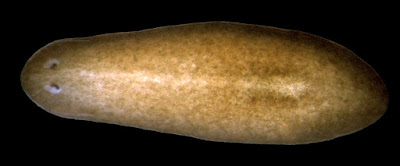Planarian Puzzles Evolutionists
A planarian is a flatworm, and there are quite a few variations. They tend to be on the small side and can be found in all sorts of watery environments, including moving water such as streams. A few of these are parasitic. Yes, the tapeworm that gets into some people's digestive tracts is a flatworm, but you are not going to get it by wading. Planaria are hermaphrodites (both male and female sex organs). They are not likely to be kept as pets, being rather unattractive among other things.
The version for our purpose is the Schmidtea mediterranea, a freshwater palanerian that is not a parasite. What has caused fascination among zoologists is the way planerians can be sliced and diced, and then the parts can grow into full-fledged planeria. Their ability to regenerate is not to be confused with that of Time Lords, which are one at a time and tend to have quirky personalities. But I digress. Regeneration is being studied for possible applications with humans and animals.
Recent sequencing of its unique genome is what caused trouble for the Darwinist timeline. Things are supposed to progress from simple to more advanced, but according to evolutionary views, 452 genes common among living things were missing, which puzzles evolutionists. Many of these were existing in "earlier" life forms, as well as those considered more recent. Such things are not supposed to happen according to Darwin's disciples, but biblical creationists are right at home with the truth: recent creation by the Master Engineer.
 |
| Schmidtea mediterranea image credit: Wikimedia Commons / Alejandro Sánchez Alvarado |
Recent sequencing of its unique genome is what caused trouble for the Darwinist timeline. Things are supposed to progress from simple to more advanced, but according to evolutionary views, 452 genes common among living things were missing, which puzzles evolutionists. Many of these were existing in "earlier" life forms, as well as those considered more recent. Such things are not supposed to happen according to Darwin's disciples, but biblical creationists are right at home with the truth: recent creation by the Master Engineer.
The planaria, a type of flatworm, has an amazing capacity to regenerate a new body from just fragments of tissue. Its genome has just been sequenced. The surprising result is a completely unexpected evolutionary conundrum.To read the rest, click on "Planaria Genome Loaded with Design Evidence".
Planarians (S. mediterranea) are a type of freshwater flatworm commonly found between about 3 to 15 mm in length. Their size can actually self-adjust within a 50-fold range depending on the amount of available resources.